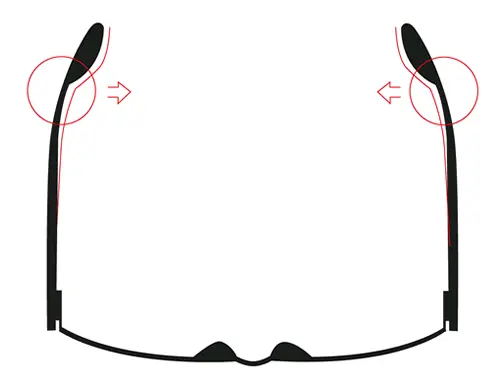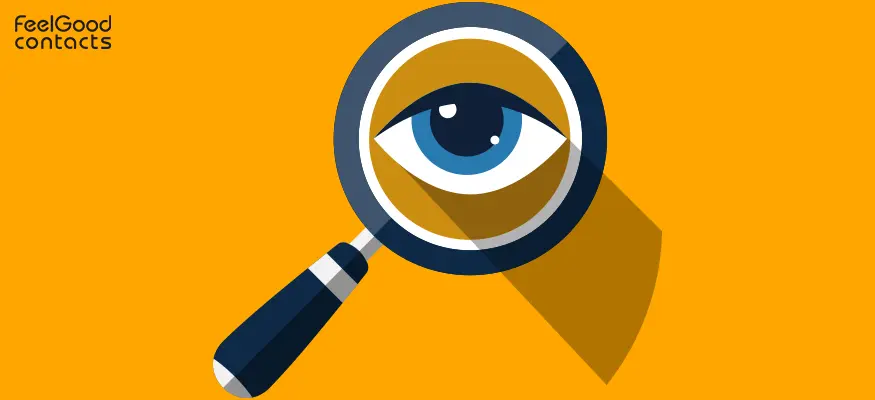
But when something feels off —dryness, blurry vision, or unexpected floaters — our first instinct is often to grab our phones and search the symptoms online.
While the internet can provide quick answers, but the accuracy of information can vary, and misinformation about eye health can often do more harm than good.
To help you separate fact from fiction, our certified optician tackled the most searched eye health questions. From “Why are my eyes twitching?” to “What causes astigmatism?”—we’ve got you covered with clear, expert-backed advice to keep your eyes in top shape.
We have also addressed some common problems that people face with the handling and fit of their contact lenses and glasses.
Scroll down for your one-stop source for frequent eye concerns or click the corresponding question in the table below to quickly get the answers you need.
Most searched eye conditions

Why are my eyes twitching? 14,800 monthly searches
Eye twitching and spasms are very common and, thankfully, rarely tend to be a result of something serious. While typically, it’s the lower lid that twitches, sometimes the upper lid or both lids can twitch at the same time.
There are various lifestyle causes for eye twitching, including stress, tiredness, caffeine, alcohol, eye strain, smoking, dry eyes, allergies, and some medications.
Most of the time, you don’t need to see a doctor for eye twitching and it’s advisable to change your routine and try reducing some of the stress factors mentioned above first.
However, if eye twitching lasts more than a few weeks, you should consult with an optician or a GP. Furthermore, you should seek medical assistance if your eye twitching is accompanied by:
- A red or swollen eye
- Unusual discharge from the eye
- A drooping upper eyelid
- The twitching lasts for several weeks
- Other parts of your face are being affected
- Full eyelid closure with every twitch
Why do my eyes keep watering? 5,400 monthly searches
There are two main reasons why your eyes could be watery:
- Too many tears are being produced
- Problems with the tear drainage system
The treatment will heavily depend on the cause.
For example, during colder, windier weather, it’s completely natural for your eyes to water. This is a reflection to compensate for the dry air, which dehydrates them by reducing the protective cushion of tears.
Sometimes, watery eyes could be a response to certain irritants, such as debris, make-up or a smoky environment. However, watery eyes could indicate more serious eye conditions as well, particularly if you experience:
- A change in vision
- Painful eyes
- Swollen eyes
- Lumps on the eye
- The eyelid turning inwards or outwards
Why do my eyes hurt? 4,400 monthly searches
It’s not unusual to experience eye pain from time to time. The good news is that it’s rarely something to be concerned about and usually goes away on its own.
Aching eyes is categorised as ocular pain, occurring on the surface, or orbital pain, which happens within the eye.
Ocular pain can have a range of causes including infection, injury, corneal abrasion, irritation through contact lens wear, or another foreign object in the eye.
Orbital pain on the other hand can indicate damage to the optic nerve, sinus infection or an inflammation inside the eye.
You can soothe eye pain at home, by trying warm compresses or giving your eyes a rest by switching to glasses if you frequently wear contact lenses.
Alternatively try flushing your eyes with saline solution to get rid of any foreign objects, or medicated eye drops if your pain is caused by certain conditions.
If the pain doesn’t stop, it’s important to see an eye care professional so they can find the root cause. Eye pain is an emergency if it’s accompanied by:
- Vision loss
- Severe eye pain
- Vision problems that occur suddenly
- Aching eyes caused by trauma
Why are my eyes bloodshot? 3,600 monthly searches
Red or bloodshot eyes are caused by the expansion of tiny blood vessels on the white part of your eyes. While symptoms can be mild, this can indicate other health issues.
More commonly, bloodshot eyes are simply the result of strained eyes from looking at screens or wearing your contact lenses for too long. Other times, this can happen if a blood vessel bursts. While this sounds dangerous, it usually isn’t cause for concern and should go away on its own.
Bloodshot eyes can also be caused by environmental factors such as smoking, alcohol consumptions and seasonal allergies. However, bloodshot eyes can also indicate more serious conditions such as eye infections or scratches to your cornea.
Soothing your eyes with a cool compress can help reduce the appearance of the redness. Likewise, avoid makeup and wearing contact lenses during this time should help your eyes regenerate. You can seek advice from a pharmacist and use over the counter medication or eye drops to provide extra relief.
If you’re experiencing pain alongside red eyes, you must consult your eye doctor as it could be a sign of something serious.
If you experience any of the following symptoms, seek medical attention immediately:
- Discomfort/pain while opening your eyes
- Photophobia (light sensitivity)
- Severe headache
- Swollen eyes/area around the eyes
- Nausea, fever or vomiting
- Blurry vision
Why are my eyes itching? 2,400 monthly searches
Having itchy eyes is very common but extremely uncomfortable. Usually, you don’t need to be concerned as this condition is the result of allergies and minor eyelid margin infections. However, it’s important to know the difference between allergies and an eye infection, so you can get the right treatment.
While it may be tempting to rub your eyes, we highly advise you not to do so. While it provides temporary relief, his could transfer harmful germs into your eyes, increasing the risk of infection. Eye rubbing can also break the tiny blood vessels around your eyes, thereby further aggravating the redness and irritation.
If you know your itchy eyes are due to allergies, the treatment for this involves medication or prescription eye drops.
If you experience itchy eyes regularly, feel pain or notice any changes in your vision, you should arrange to see your optician immediately. They will be able to identify the cause of your itchy eyes and recommend the best treatment for you.
Most searched eye diseases

Glaucoma symptoms - 18,100 monthly searches
Losing your vision is a very scary thought. A particularly sneaky and well-known disease is glaucoma, which is a group of eye problems that harm the optic nerve.
Inside your eye, there's a fluid called aqueous humour. Your eye constantly makes this fluid, and extra fluid goes out through tubes. The optic nerve links your eye to your brain. If the fluid doesn't drain properly, it builds up and increases the pressure inside your eye. This damages the optic nerve over time, and if not treated early, it can lead to vision loss.
While it is reassuring that lots of people are searching for the causes of glaucoma, unfortunately symptoms are not easy to identify and can sometimes stay undetected until it’s too late.
It is therefore advised that people attend regular eye tests, especially those who present with certain risk factors.
You are more likely to suffer from glaucoma if you:
- Are a woman
- Are over 40 years old
- Have high myopia (short sight)
- Have high hyperopia (long sight)
- Have hypertension/high blood pressure
- Are diabetic
- Have family history of glaucoma
- Use steroid medication
Conjunctivitis symptoms - 18,100 monthly searches
More commonly known as “pink eye”, conjunctivitis refers to an inflammation of the conjunctiva, which is a thin layer of tissue that covers the front of the eye. There are various causes of conjunctivitis:
- Bacterial conjunctivitis: Bacterial overgrowth in the presence of excessive meibomian oil secretions lead to an inflamed eye with sticky discharge – can be caused by contaminated make-up and sharing contact lenses
- Viral conjunctivitis: Can occur if you’re exposed to somebody with an upper respiratory tract infection.
- Ophthalmia neonatorum: In new-born babies, conjunctivitis should be taken seriously. Some infections may be due to exposure to pathogens associated with sexually transmitted disease, such as Gonorrhoea and Chlamydia in the birth canal. Gonococcal infections can lead to perforation of the eye.
- Chemical conjunctivitis: This is frequently caused by highly perfumed beauty products which can irritate the conjunctiva.
To prevent conjunctivitis, we recommend you avoid touching your eyes, wash your hands often and thoroughly with warm soapy water, don't share makeup or face creams and make sure your towels and pillowcases are clean and avoid sharing them.
Various symptoms can help a doctor diagnose the type of conjunctivitis one has. As some symptoms are the same, it can sometimes be challenging to make a diagnosis. For this reason, your doctor may take a sample of your eye discharge to test in a laboratory.
Dry eye symptoms - 14,800 monthly searches
Your eyes become dry when the eyes don’t produce enough tears or when the tears evaporate too quickly.
High humidity in the air indoors while the central heating is on can also cause dry eyes.
You should drink plenty of water to keep your eyes hydrated when the air is drier outside. Artificial tears can also be a great way to keep your eyes lubricated if you find that they are not producing enough tears themselves.
Even though it is tempting to fully blast the heat while you are indoors to warm up, consider lowering the temperature or heating in shorter cycles to prevent your eyes from drying out.
If you must have the heating on for extended periods, using a humidifier can help towards alleviating dry eyes in winter.
While some causes are environmental, it is important to never ignore chronic dry eye syndrome. Not only can having dry eyes cause discomfort and pain, but it can also permanently damage your vision if left untreated.
You are likely to be more at risk of getting an eye infection without adequate tears. A lack of lubrication means that your eyes are more likely to suffer abrasion of the corneal surface, a corneal ulcer or eye inflammation.
What is astigmatism? 8,100 monthly searches

Astigmatism is one of the most common refractive errors that affect vision. It is an eye condition caused by an irregular curvature of the cornea, lens, or both.
Alongside myopia and presbyopia, it is one of the most common types of refractive errors.
Astigmatism is caused by an irregular curve on the eye's front surface (cornea). A ‘normal/ spherical’ eye is round, like a football, whilst an eye with astigmatism has two different curves, similar to a rugby ball.
Symptoms of astigmatism depend on the severity of the condition. Some of the symptoms are listed below:
- Blurred vision is the most common symptom of this condition, making it harder to see details such as print on the newspaper or a faraway road sign. This pressure of trying to focus can also cause eye fatigue and headaches.
- Squinting to see clearly can be an indication of astigmatism.
- You might face difficulty seeing at night, because of seeing glare or halos caused by streetlights and car headlights.
- Headache or eyestrain - with blurry vision, your eyes will work harder to focus causing eye fatigue and headaches.
- Too much pressure on the eye can make your eye feel irritated
- Double vision
Try out interactive vision simulator to see how astigmatism can affect what you see.
What causes cataracts? 2,900 monthly searches
Cataract is a common eye condition that affects millions of people worldwide. This condition is characterised by the clouding of the eye's natural lens, which can lead to blurred or distorted vision.
The lens, which is normally clear, becomes opaque due to the buildup of protein, hindering the passage of light and affecting vision.
Cataracts are commonly seen among older people, while some cases of cataracts can be found in children as well.
While cataracts are a natural ageing process, as the proteins in the eye lens clump up over time, it can also be caused by:
- Genetics: family history of developing cataracts can increase the risk
- UV radiation: prolonged exposure to harmful UVA/B rays of the sun
- Medical conditions: diabetes, hypertension, or eye injuries
- Intake of certain medications: long-term use of steroids or specific medications.
While there is no cure for cataracts, they can be treated through surgery. Cataract surgery involves removing the cloudy lens and replacing it with an artificial intraocular lens (IOL). The procedure is safe and effective and has a high success rate in restoring clear vision.
Most searched contact lens questions

What happens if you sleep in contacts? 7,510 searches
Sleeping in contact lenses is a common mistake, whether due to sheer exhaustion or simply forgetting after a night out. However, it’s worth noting that unless you’re using lenses specifically designed for overnight wear, sleeping in contacts increases the risk of issues like dry, gritty eyes, corneal abrasions, or even infections such as conjunctivitis.
If you accidentally fall asleep with your lenses in, don’t panic. Wait five to ten minutes after waking to let your eyes rehydrate naturally, then use lubricating eye drops to make removing the lenses easier.
If this happens frequently, like after naps or nights out, you may want to ask your optician about switching to extended wear lenses designed for overnight use. However, removing your lenses before sleeping is always the best option to keep your eyes healthy and protected.
How can I tell if my contacts are inside out? 6,230 searches
You’re not alone if you’ve ever squinted at your contact lens, wondering which way is up. While putting a contact lens in inside out won’t harm your eye, it can certainly make things less comfortable, so here’s how to tell.
One simple test is to see if the lens resembles a saucepan with flared edges; if it does, it’s inside out and needs flipping. Some lenses include numbers or markings on the rim. If these appear reversed, this is another sign the lens is the wrong way around.
Another popular trick is the ‘taco test,’ where you gently squeeze the lens between your fingers. If the edges curl inward like a taco, the lens is correctly positioned. If they flare outward, it’s inside out.
Ultimately, the best way to tell is by the feel of the lens in the eye once inserted. If your vision is blurry or your eye feels scratchy, then it’s likely the wrong way around. Simply remove it, rinse it with solution, and then reinsert it the right way.
How to put contacts in? 3,600 searches
For many, inserting contact lenses when they’re first starting out can feel daunting which explains why this is a common question on the web.
Over time, applying lenses will become second nature, but in the beginning, it’s important to be patient. Start with clean and steady hands to avoid introducing dirt or irritation.
Make sure your lens is oriented correctly before inserting it, as this avoids discomfort from an inside-out lens. Practice is key, take your time and don’t rush it. If you still experience discomfort or irritation, consult your optician to rule out any underlying issues.
Can a contact lens get stuck behind my eye? 1,900 searches
Please stop panicking as it’s impossible for a contact lens to get stuck behind your eye, even though it can sometimes feel like it’s vanished.
If your contact lens does get lost in your eye, the most important thing to do is stay calm. After washing your hands, use lubricating eye drops to moisten your eye, as this will help loosen the lens. Next, close your eye and gently massage your eyelid toward the centre. This can help guide the lens back to the cornea, making it easier to remove.
For gas-permeable type lenses, applying plenty of drops helps to gently remove it once the eye is well hydrated.
You should seek help from your optician or visit A&E if these steps don’t work or you’re still struggling to find the lens.
Most searched glasses questions

How to tighten glasses? 1,300 searches
If you wear glasses and have worn them for a while, you may have experienced that they begin to slip off your face over time.
Loose glasses can be annoying to keep pushing back up again. They can also end up looking crooked and not sit well on your face, affecting your line of sight.
If your glasses are loose, you’ll need to bend the left arm and/or the right arm. Simply heat up the plastic temple part of the frame and gently bend the arms towards each other around the area of the temple tips.
You can heat up the frame by using a hair dryer for 20-30 seconds.

If your glasses are too tight or are sliding down your face, you may need to run the temple tips under warm water for 30-60 seconds before bending them into place. You can also use a hairdryer for 20-30 seconds. Top tip: Whatever you do, avoid putting your lenses under hot water as this can damage them.


Avoid making large adjustments to your glasses at once. This could make the problem worse and more difficult to correct. As always, it is best to visit your optician to have a full adjustment of your glasses.
How to know if I need glasses? 1,000 searches
If you have trouble reading small texts or noticed any other recent changes in your vision, it’s best to visit an optician to have a professional eye exam.
We also have an interactive quiz which can help you decide whether it’s time to book an appointment with your local opticians. (This could be embedded into the blogpost, if possible)
Which glasses suit me? 170 searches
There are so many fantastic eyewear colours, styles, silhouettes and designs to choose from. This can make it challenging to know which prescription glasses frame to choose and which glasses style will suit your face shape the best.
If you face shape is square: People with square faces frequently choose round or oval frames, as well as Clubmasters. The theory is that the soft curves of rounder frames have an appealing contrast to the lovely sharp edges of a square face.

If you face shape is round: Angular shaped frames such as square and Wayfarer frame styles tend to look particularly good on round faces. They add dimension and balance, which make them a good option for round face shapes to try. Oval, round and cat eye frames can make faces appear slightly wider.

If your face shape is rectangle: Thick Wayfarer, Clubmaster, cat eye and square frames give the illusion of greater width and create balance. For longer faces like rectangle shaped faces, thicker frames often look comfortable and natural.
They create a break in the length of the face, so people with rectangular faces might find that these are a good choice for them. Bold prints, bright colours and splashes of retro neon are a nice additional feature that pairs well with a rectangle frame.

If your face is heart shaped: Cat eye and rounder frames are perfect choices for heart-shaped faces. Lighter frames with thinner rims, or even rimless glasses, also add a soft touch for those who like a barely-there look.
Transparent and pastel-coloured frames have a similar effect, while darker, more angular frames might distract from the beautiful natural structure of a heart-shaped face.

Eyeglass nose dents – 90 searches
Do you have glasses that keep sliding off your face or are not sitting well? Chances are your glasses’ nose pads need some adjustments if you have a frame with nose pads.
With time, it’s common for your glasses to not fit you perfectly. However, it is important to resolve the issue to have a good vision.
Read more in our guide on how to adjust different types of nose pads so they don’t leave dents anymore, or watch the below video:
Conclusion
Your eyes are priceless, and taking care of them starts with getting accurate, reliable information. In this post, we’ve tackled some of the internet’s most searched questions about eye diseases, common symptoms, contact lenses, and glasses, providing expert-backed answers to help you feel confident in your eye care decisions.
While it’s natural to turn to Google for quick answers, remember that nothing replaces the value of professional advice from a qualified optician or eye doctor. If you’re experiencing ongoing symptoms or have concerns about your vision, don’t hesitate to schedule an in-person consultation.
Disclaimer: The advice in this article is for informational purposes only and does not replace medical care or an in-person check-up. Please check with an eyecare professional before purchasing any products or remedies.
Sources & Methodology
Using Google search data and Answer the Public we have found a variety of the most common googled eye questions including general eye, contact lens and glasses specific questions.
Data correct as of 27/11/2024.
























